Tuesday, October 25th, 2011
By Carolyn Yeager
…instead of the world’s most famous Holocaust survivor?
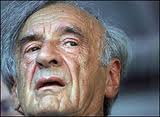
Just one year ago, Elie Wiesel gave a speech in Connecticut, while a jury was in session just miles away, calling for the death penalty to NOT be given to two men who had committed an appalling crime against a family of four. Wrapping himself in self-righteousness, he intoned “Death is not the answer” to the man, William Petit, who had lost his wife and two beautiful young daughters to a couple of amoral monsters, and to Petit’s supporters.
The crime committed was so brutal and horrible, and senseless too, that for this writer the death penalty is too good for these perpetrators. You can read about it here and here.
Did Elie Wiesel have the right to barge into this family’s tragedy as some sort of “spiritual advisor”, for which he was not asked? Of course not. Did he have any right to bring his “holocaust experience” into their personal grief as some kind of Jewish lesson in humanity? No, and it’s in the worst of taste but he is used to flaunting his imaginary suffering to audiences who have been indoctrinated and conditioned to respond like Pavlov’s dogs to his trite phrases.
The murderers of this family should not be given the death penalty, says Elie Wiesel.
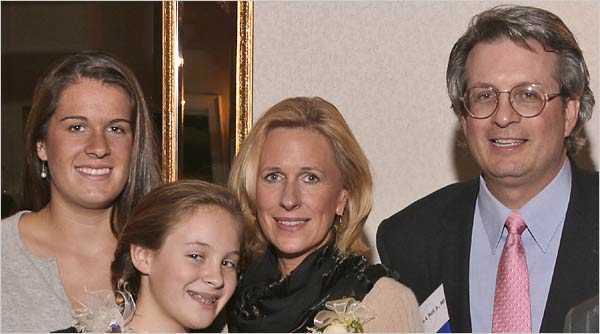
Left, Haley, 17 and Michaela, 11 with their 48 year-old mother Jennifer Petit–all torture-murdered. Sole survivor William Petit on right.
Wiesel tells them, “I know your pain … believe me, I know.” Does he? He is oblivious to this man’s pain when he tells him he should not desire the death penalty for those who committed such savage acts upon his loved ones. We know exactly what happened to these three women with horrifying exactitude. We do NOT know what happened to Wiesel’s mother, father and sister. With the Petits we have the bodies, and the manner of death and the culprits are forensically determined; not so with Wiesel’s family and so many others–no bodies and no forensic evidence at all. Their deaths, especially in the manner assumed, remain conjecture.
It seems Wiesel wants to prevent Gentiles from getting justice for evil done to them, while justice for Jews has always required full punishment … an eye for an eye. He recently called for bringing Mamoud Ahmadinejad to trial as a war criminal at the Hague simply because he has said he doesn’t believe in the mythical Holocaust. Wiesel wants to make holocaust denial a crime in the U.S. and put “deniers” in prison. Yet he also wants these child rapists and souless murderers to remain in prison for life, being fed, clothed and given health care, side by side with holocaust deniers!
Is Elie Wiesel an evil force in the world or just a fool?
Iran has the death penalty. We need the death penalty to deter human trash like these two murderers. Wiesel’s campaign to abolish the death penalty in the U.S. is part of the attempt to further destroy our society and beautiful, gifted white people.
“Death is not the answer” for men who tie girls to their beds, rape them, douse them with gasoline and set them on fire, says Elie Wiesel.
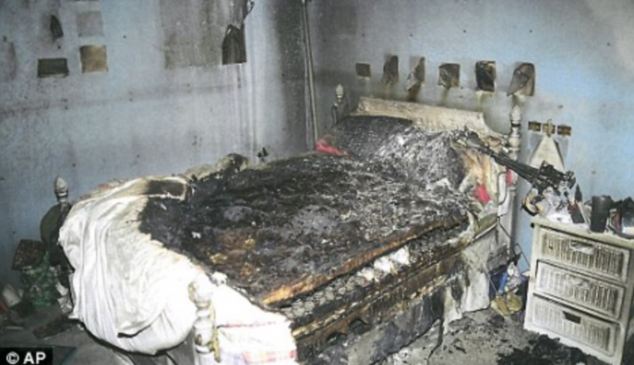 Haley’s bed on which she was tied to be burned to death. The same was done to her younger sister.
Haley’s bed on which she was tied to be burned to death. The same was done to her younger sister.
What we know happened in Cheshire, Connecticut has no relation to what happened to Elie Wiesel’s family in 1944 in Hungary and Poland. I believe it is the fire–the torching of the live bodies and of the house itself–that drew Wiesel’s attention to this case. The religio/historical accounts written by Jews, such as in the Talmud, are suffused with stories of being burned (destroyed) by fire. Elie Wiesel himself coined the term “holocaust” to describe the expulsion, deportation and incarceration (not incineration) of Jews in concentration camps that took place in 1942-45. Even though many deaths did occur, none were by fire or burning. However, Jewish mythology demands fiery deaths.
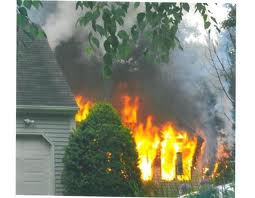
Left: The Petit family home set ablaze by the murderers to conceal their DNA.
In addition to his offensiveness to Petit and his sister and mother who attended the trial with him, Elie Wiesel is a hypocrite because he never said “Death is not the answer” when Germans were being put to death by the hundreds as “Nazis” and nazi collaborators. He never said “Death is not the answer” when Adolf Eichmann was sentenced to die by an all-Jewish court proceeding in Israel. He never said “Death is not the answer” as Israelis murdered Palestinians in secret prisons. But once he decided to make a reputation for himself as a humanitarian, he has taken up opposition to the death penalty.
Why the death penalty? Well, to prevent justice for families like the Petits, who are white and blonde. Their sufferings should never be taken as seriously as the ‘holocaust of the Jews.’ Wiesel has likened the death of a Jewish child as equivalent to, or greater in significance than, the death of Jesus Christ. The burning death of 11 year-old Michaela can never be allowed to compete with a Jewish child.~
Addendum (added Wed. Oct. 26)
Both of the murderers have been found guilty and one, Steven Hayes, has been given the death penalty. The younger man, Joshua Komisarjevsky is currently back in court for the penalty phase which began yesterday. His attorneys plan to highlight Komisarjevsky’s “troubled” childhood, and that he didn’t get the “help” he needed.
Well, of course, people who do things like Hayes and Komisarjevsky did have “troubled childhoods;” there is something wrong with them from birth. But all those who experience difficult childhoods don’t do what they did. We cannot allow offenders to weasel out of paying an appropriate price for their destruction of other’s lives and property; if we do, no one can be held responsible for anything … which is pretty much what has happened to our society.
Even if this sick person also receives the death penalty, which I hope he does, it will be years before either one of them faces what the jury recommended for them. In the meantime, Elie Wiesel will be doing all he can to help them weasel out of it.
29 Comments
Category Featured | Tags: Tags: Elie Wiesel, hypocrite, Jennifer Petit, Jr, William Petit,
Social Networks: Facebook, Twitter, Google Bookmarks, del.icio.us, StumbleUpon, Digg, Reddit, Posterous.
Sunday, October 16th, 2011
By Carolyn Yeager
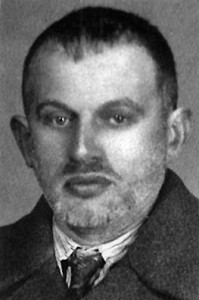
Elie Wiesel’s father Shlomo in 1942, according to Hilda Wiesel.
Is he 39 or 48 years old?
A report in the Yad Vashem Shoah Victims database by Yaakov Fishkovitz contradicts Elie Wiesel’s story about his father’s death.
Yaakov (Jacob) Fishkowitz filled out a death form in 1957 for his cousin Shlomo Wiesel, shortly after Yad Vashem first began its “Central Database of Shoah Victims Names.”1 He also filled out a form for Shlomo’s mother Nisel Basch Wiesel, his aunt. The cousins shared a maternal grandfather, Moshe Basch.
Yaakov was the son of Mentza Basch, daughter of Moshe, and Fishel Fishkovitz. Yaakov recorded Shlomo’s date of birth as 1903, which is much later than has been assumed, making Elie Wiesel’s father only 40 years old when he died! However, since Wiesel himself was 14 or 15 years old in 1943 this makes a lot more sense for an Orthodox Hasidic father-son. I will examine this further on in this article.
As seen in the two Yad Vashem Shoah Victim reports below—one by Fishkovitz and the other by Elie Wiesel—Yaakov spells the last name as both Wiesel (German) and Vizel (Roumanian). The German ‘W’ is pronounced as the English ‘V;’ similarly with s and z. He also gives both the formal name Salomon and its casual form Shlomo. Elie, on the other hand, spells his father’s name as Vizel and his own name as Eli Vizel, dropping the ‘e’ in his first name that he adopted for his post-war identity.
Shlomo’s children have never or seldom used the formal ‘Salomon’ for their father, but they do agree that Eleizer (or Leizer) and Nisel were his parents and that he was born in Sighet; that he was married and operated a store. Yaakov uses the word “merchant” while Elie uses “shop owner.” Elie adds his mother’s name, Sara Feig, but leaves his father’s date of birth blank, while also giving an incorrect date for his death according to his own book, Night.
The details from the forms (the form itself is shown in upper left corner), are translated into English from the Yiddish that was used by Elie and partially by Yaakov to fill out the forms. However, the dates can be read. The first one is by cousin Fishkovitz in 1957; the second one by son Elie in 2004, almost 50 years later.
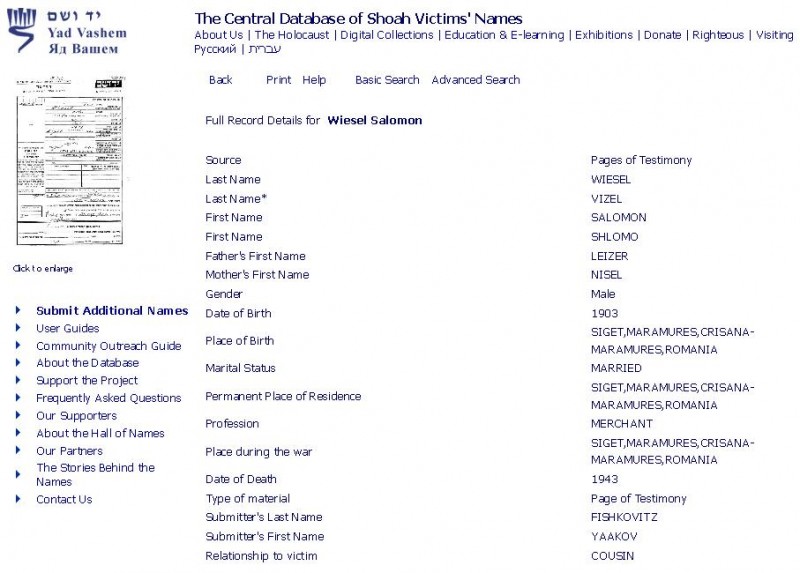
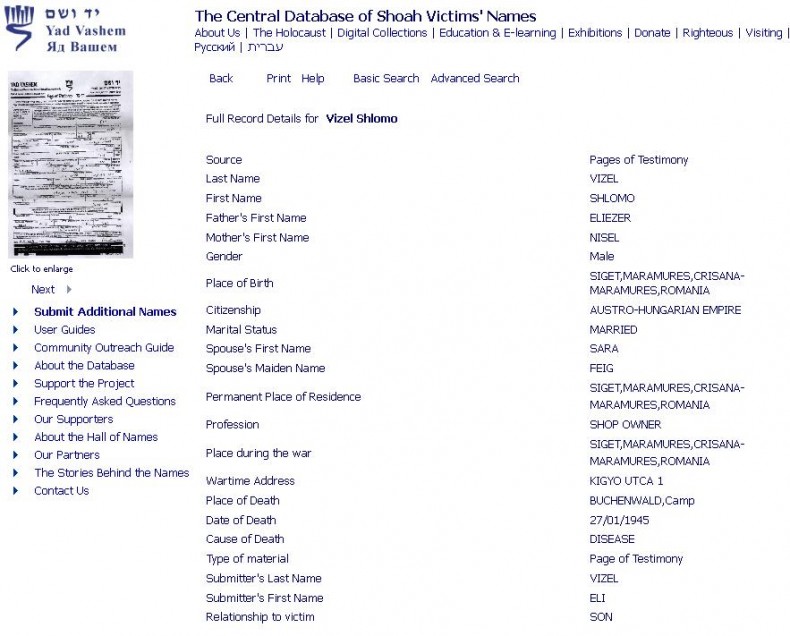
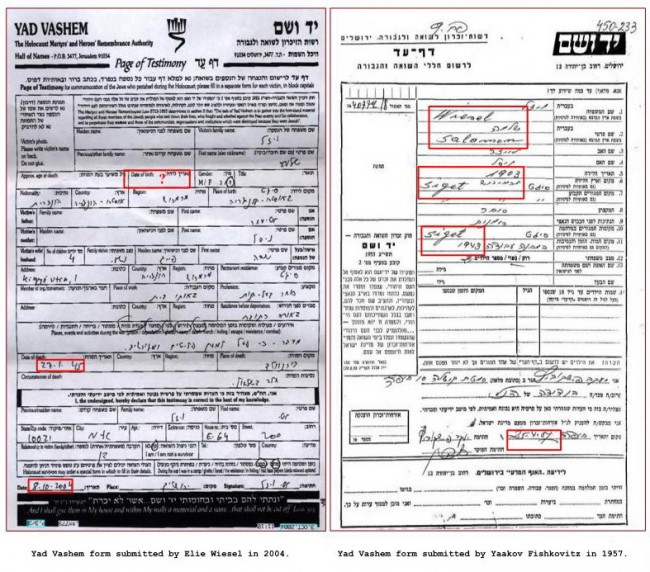
(Click on forms to see a larger, full image.) Notice that each submitter fills in what he knows or believes to be important. Yaakov knew the year of his cousin’s birth; it may have been close to his own. Elie did not know, or doesn’t want us to know. He has never written it or given that information to an interviewer. This is important, but even more important is that Yaakov says Shlomo died in 1943 in Sighet*, the year before the deportation of the Jews of Sighet! This changes the entire narrative. [*Correction was made in a later article: it actually says Shlomo lived in Sighet during the war; he died in a labor camp in 1943.]
What evidence do we have for Shlomo’s age?
In Elie Wiesel’s Night (“a true story, every word is true”) Eliezer’s father answers “fifty” when asked his age by a friendly Jew when they first arrive at Auschwitz in May 1944. Eliezer answers that he is fifteen years old. The Jew tells them to lower and raise their ages respectively, which they do. (Even so, they’re put in a line that takes them right up to the edge of a pit of fire before they are turned away.) Because of this, Shlomo Wiesel has generally been assumed to have been born in 1894, although that has never been verified. For example, Wikipedia does not give a date.
In Hilda Wiesel’s Shoah Foundation testimony, she shows the photo of her father that is at the top of this article, and says it was taken in 1942. Does he look like he is 39 in this photo (born in 1903) or does he look to be 48 (because he was 50 in 1944)? It’s impossible to tell for sure, but he looks like a youngish man to me.
As we know, there are no records at Auschwitz-Birkenau or Buchenwald for a Shlomo Wiesel that fits his profile. Nor are there any for Elie Wiesel and his profile. The records that are used by the “Wiesel-in-Buchenwald” supporters are those for Abraham Viezel (also spelled Vizel or Wiesel), born Oct. 10, 1900 in Sighet, who died at Buchenwald on Feb 2, 1945. He died in Block 57; the death report was made out on Feb. 3, the following day. Yet Elie Wiesel claims in Night and elsewhere his father died on Jan. 28 and was carted off to the cremation ovens immediately, fully 5 days before Abraham’s death took place.
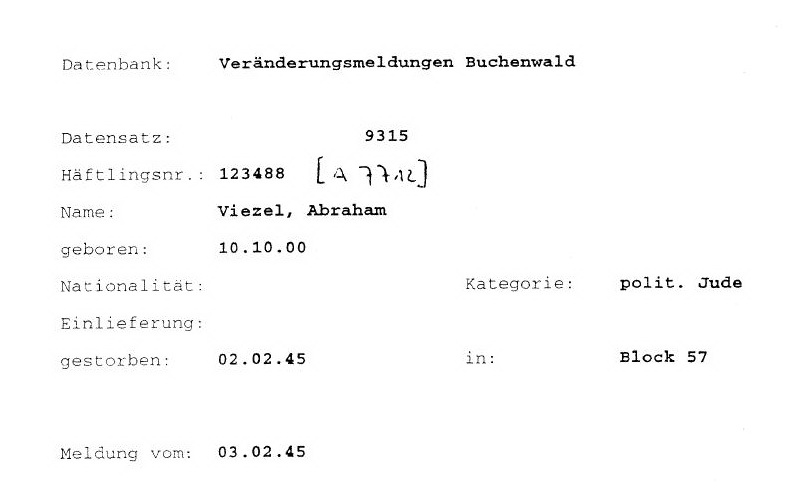
Death record for Abraham Viesel at Buchenwald, brother of Lazar Wiesel whose Auschwitz # was A7713
This Abraham Viesel is the same Abram Wiesel who was the older brother of Lazar Wiesel, according to Myklos Gruener, who says the two brothers had become his comrades at Auschwitz-Birkenau after the death of his father. (Auschwitz records exist for Myklos, his father and two brothers, as well as for Lazar and Abram Wiesel, including each of their numbers.) Abram’s Auschwitz tattoo number A7712 is written by hand on this death record, as well as his Buchenwald number, 123488.
If Shlomo died in 1943, this would explain why there is no death record for him at Buchenwald. Are there any other convincing reasons to go along with the 1943 date? Yes. In Night and in All Rivers Run to the Sea, we’re told of Shlomo’s resistance work helping Jews with legal problems and those who needed to flee from one place to another. He had been jailed for it, something mentioned by both Elie and Hilda. Elie characterized his father’s tireless efforts as “out of a loving, helpful heart.” But was his father, and his family, more radical than we’ve been led to believe? Was Shlomo’s life a dangerous one? Were there disputes about money—money collected to buy weapons, or for passage to safe places? Or perhaps there was anger within the Jewish community over who was being helped and who wasn’t?
In All Rivers, on page 4, Wiesel writes that as a child and adolescent he “saw his father rarely […] The Sabbath was the only day I spent with him.” “Often preoccupied,” his father spent the week in his little grocery store and at the “community offices where he worked to assist prisoners and refugees threatened with expulsion.” Expulsion from where? By whom? What were the community offices? Wiesel names Sighet as a “sanctuary for Jews fleeing …since 1640.”
What knowledge can we piece together about Shlomo?
Shlomo was a preoccupied man. He ran a store. He took in deliveries. He may have been involved in smuggling – guns, people, documents. Smuggling was a way of life among the Zionists. Jews began going to Palestine long before Elie Wiesel was born. There were different factions of Jews—the Haganah was formed in 1920 to guard Jewish settlers in Palestine. In 1931 the Irgun splintered off and there was sometimes bitter enmity between the two organizations all the way up to 1948. The Irgun policy was that every Jew had a right to enter Palestine and it became the major smuggling arm for the Zionists. The Irgun worked in Poland, for example, in the 30’s to bring Jews into Palestine with the cooperation of secret agencies of the Polish government. (See “The Role of the Irgun in Central and Eastern Europe” at http://www.eliewieseltattoo.com/elie-wiesel-and-the-mossad-part-ii)
It is fully possible that as things heated up in 1943, Shlomo got caught in some crossfire — perhaps was killed by the Hungarian police. If this were the case, Elie, as only son, may have been sent to France for safety before the deportations of Spring 1944. Further, if this were the case (a story as good as any other), Elie was an Irgun-supporting Zionist from an early age, which fits everything we know about him.
On page 8 of Night, Wiesel wrote:
In those days [Spring 1944] it was still possible to buy emigration certificates to Palestine. I had asked my father to sell everything, to liquidate everthing, and to leave. ‘I am too old, my son,’ he answered. ‘Too old to start a new life. Too old to start from scratch in some distant land …’
If he were only 40, that is not credible. Even at 50 he was not too old, unless he really didn’t believe the worst would happen and that things would right themselves. His children were certainly not too old and he would have them to look after him in his old age. Something doesn’t add up here. This “good man” doesn’t protect his family because he feels too tired at age 40-50 to go somewhere new? He allows them all to be taken prisoner because he can’t see what’s coming, even though he’s spent his adult life helping Jewish prisoners and refugees? Wiesel often fails to give convincing explanations for why events happen as they do in his writings. I have noticed it again and again, and commented on it. It seems to me to be a combination of laziness and lack of true inventiveness. He has admitted that he was rather spoiled and lazy in his childhood and youth; one doesn’t see any evidence of change.
The age of the typical Hasidic bride and groom
Back to the question of the appropriateness of Sholmo Wiesel being age 40 in 1943-44. The Hasidic sect sees the ideal age of marriage for a male as 18-21. They encourage the bride and groom to be close in age. Taken from the New York Times article on an important Hasidic wedding:
What they saw was a marital merger of two leading international Hasidic dynasties, the Bobovers of the Borough Park neighborhood in Brooklyn and the Satmars of Williamsburg. The 19-year-old groom is a grandson of the Bobover Grand Rabbi, Shlomo Halberstam. The 18-year-old bride is a granddaughter of the Satmar Grand Rabbi, Moses Teitelbaum. The two grand rabbis are the descendants of the first Hasidic leaders in Europe. They are also first cousins and close friends.2
Another Hasidic wedding is announced, this one in Israel.
Even longtime Hassidim are raising their eyebrows: A 16-year-old young man is engaged to his 15-year-old second cousin, both great grandchildren from “Hassidei Vizhnitz.” Thousands of members of the Vizhnitz Hassidic sect, one of the largest and wealthiest in the world, are expected to attend the festive wedding ceremony, which will take place in approximately another year.3
If Shlomo were born in 1903, as Yaakov Fishkowitz has it, he would have been 25 years old in September 1928 when his third child and first son Eliezer was born. His first child Hilda was born in August 1922, when he would have been 19 years old. Perfect for a Hasidic man!
On the other hand, if he were born in 1894, he was already 34 when Elie was born, and 28 when he had his first child. That is too old and is not in the tradition of his community! That may be why Wiesel avoids mentioning his father’s date of birth; it does not fit the story of Night, which he adopted as his own. Here’s a thought: Is there an Hasidic law or tradition that forbids lying about one’s parents and other ancestors? Probably, which can be the reason he says so little about his father, mother and grandparents as far as checkable data goes.
Is it not strange for the ‘High Priest of Memory’ to be so negligent in recording the history of his family? He only filled out the Yad Vashem form (with a camera aimed at him) at the behest of that institution, as an encouragement to others to do the same. That was admitted in the TV publicity given it. Plus it is the only Shoah victim form he filled out. His mother and sister are not in the Yad Vashem Shoah Victim database! He says it’s because he’s written about them in books, so the bare facts on a form are not necessary. But in his books, he doesn’t give dates or checkable details. Why has no family member recognized the death at Auschwitz of Sara Feig Wiesel and her daughter Tzipora by filling out a form?
Is Elie Wiesel’s story about his family and their fate entirely or just partially false?
We know Wiesel’s story about his family and youth to be full of falsehoods. His book Night has been lampooned as much as it has been praised because of the contradictions and inappropriate descriptions of people and events it contains. He has long been described as a fabricator, an exaggerator, a false witness. However, here at Elie Wiesel Cons the World our mission is to expose every lie, not just the most obvious of them. So we dig deeper.
Elie Wiesel has every reason to want his father with him at Buchenwald since the story in Night, which started out as fiction, is about a son and his father. The story also says his mother and younger sister perished on their first night in Birkenau. But if Shlomo died in 1943 and never went to Auschwitz, did any of his immediate family go? Remember, there are no records for any of them there.
Could Elie Wiesel have known in 1955 how huge the Holocaust Industry would become? No, no one did. Would Elie Wiesel in 1958 have anticipated the intense scrutiny of this book Night, or his own star status in which he himself would come under intense scrutiny? No, again. Elie Wiesel didn’t prepare for the kind of future he turned out to have, so he’s been “playing it by ear” ever since—and using his untouchable Jewish holocaust survivor status with which to protect himself. His sisters and other family members and friends were silenced to keep the ‘wrong’ information from slipping out. Journalists were obviously ordered to stay away from them!
But, perhaps unbeknownst to their inner circle, there lay two victim reports with vital information relating to Elie Wiesel in the Yad Vashem databank filled out in 1957 by Yaakov Fishkovitz, one of which is displayed in this article. The other is for his aunt—Shlomo’s mother—Nisel Basch Wiesel, stating she was born in 1881 and died in 1944 at Auschwitz (in her 63rd year). Another form for Nisel was filled out in 1999 by her grandson, Eliezer Shlomovitz, living in Los Angeles CA. He gives her date of birth as 1880 with a question mark. I will write about Nisel Wiesel in a separate article, but for now I want to establish that if Nisel were born in 1880-81 she would have been only 13 years old when she gave birth to her son Shlomo, if he were born in 1894. Since Shlomo was not her first child, but perhaps even her fifth or sixth (undetermined as of now), this is clearly impossible. If Shlomo were born in 1903, it is doable.
Thus, we have every reason to doubt everything about Elie Wiesel’s story of his family history and their concentration camp credentials. I will continue with this fascinating and very important examination of the Wiesel extended family in an upcoming article. Stay tuned.
Endnotes:
1. Yad Vashem was established in 1953 as the official “remembrance authority” (for the Jewish Shoah) by the Knesset, Israel’s parliament. At that time, Jews were told that all Jews who died at the hands of the Nazis or their accomplices during the years of Nazi power, i.e. 1933-1945 could be considered Shoah victims. This includes Jewish soldiers serving in the Soviet and Polish armies, who were taken prisoner and died in Nazi POW camps. Jews who survived until the liberation but died within six months of liberation are also considered Shoah victims.
Another category is ‘Shoah survivor’ All those living in Nazi-occupied territories from 1933 onward could be considered victims of the Nazis, including French, Bulgarian and Romanian Jews, and even those who went deep into the Soviet Union. Also included are “Jews who forcefully left (?) Germany in the 1930s.” Even those who went to Israel, obviously No other group has so generously allocated ‘victim-opportunities’ to its people. This is called Chutzpah in Yiddish. (Information taken from http://www.yadvashem.org/wps/portal/!ut/p/_s.7_0_A/7_0_S5?New_WCM_Context=http://namescm.yadvashem.org/wps/wcm/connect/Yad+Vashem/Hall+Of+Names/Left+Links/en/3HON_FAQs)
2. http://www.nytimes.com/1998/09/04/nyregion/a-royal-wedding-a-family-affair-two-hasidic-dynasties-unite-in-brooklyn-gala.html?pagewanted=all&src=pm Further of interest: The Satmars originated in Hungary and the Bobovers came from Poland. […] Because Hasidic families often have 10 or more children, the two groups now have tens of thousands of followers in Brooklyn and more around the world.
3. http://www.israelnationalnews.com/News/News.aspx/133130 “We have a tradition of marrying at a young age, but we usually mean 19-22, although there have been occasions of marriages before the age of 18,” one Vizhnitz member told the Hebrew-language daily Yisrael HaYom. “However, marrying at the age of 15 is definitely exceptional.”
Please read this article next: New Information – Shlomo Wiesel dies in labor camp in 1943?
14 Comments
Category Featured | Tags: Tags: Abraham Viesel, Buchenwald, Elie Wiesel, Hasidic marriage, Hilda Wiesel, Night, Shlomo Wiesel, Yaakov Fishkovitz, Yad Vashem Shoah Victims Database,
Social Networks: Facebook, Twitter, Google Bookmarks, del.icio.us, StumbleUpon, Digg, Reddit, Posterous.
Tuesday, October 11th, 2011
By Carolyn Yeager
Elie Wiesel joins Israeli Settlers and Intelligence Chiefs to Celebrate Theft from Palestinians
One of the leading land-grabbers in East Jerusalem is a settler non- governmental organization by the name of Elad. Elad’s goal is to rid Jerusalem of Arabs. One of its tactics has been to have Palestinian homes declared archaeological sites, whereby the homes can be taken over and the owners/residents evicted. It will do so by hook or by crook, says a left-leaning Jewish website Tikun Olam.
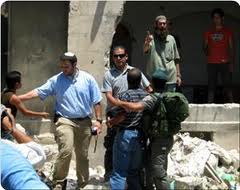 Left: Guarded Israeli settlers seize new house in Jerusalem from Palenstinians.
Left: Guarded Israeli settlers seize new house in Jerusalem from Palenstinians.
Joining these settlers at their commemoration service on behalf of this enterprise is Nobel Peace Prize winner Elie Wiesel. Not only that, he’s the chair of Elad’s Advisory Board. Also attending the commemoration as friends of Elad were two former Israeli intelligence chiefs, Shabtai Shavit and Amos Yadlin, and a number of prominent officials.
To Wiesel, anyone who is a friend of Israel is a friend of his.
Another friend is John Hagee. In 2009, after reportedly losing a large sum of money he had invested with Bernie Madoff, Wiesel made a cool half million for one speech to Hagee’s Christians United for Israel (CUFI) benefit. During the celebration of the Feast of the Tabernacles at Hagee’s San Antonio TX mega-church, Wiesel was keynote speaker on the “Night to Honor Israel.” CUFI gave $9 million to Israel charities that night, of which $500,000 went to Wiesel’s Foundation for Humanity.
Wiesel has also joined Alan Dershowitz in sponsoring a Jewish anti-Iran group. In an interview by John Hagee, Wiesel said of Iran’s leader Mahmoud Ahmadinejad:
“… this man is a disgrace to humanity. […] This man is the No. 1 Holocaust denier in the world. This man publicly, repeatedly says that he needs, that he wants nuclear weapons to wipe off the Earth one Jewish state. This man should be arrested and brought to Hague to face the international tribunal and charged with the incitement of crimes against humanity. He does not deserve to be a president of any country. He should never be accepted anywhere as a guest, neither to New York nor to Paris, nor anywhere. He must be a persona non grata all over the world.”
Clearly, Wiesel thinks nations should not be allowed to choose their own leaders. They must be vetted by Israel. If they are not friends of Israel, they should be accused of incitement of crimes against humanity and shunned everywhere. He called the Goldstone Report a “crime against the Jewish people.”
Criticism of Elie Wiesel from the liberal left is growing. However, they tend to put it in this way:
“I’m sorry to say that Wiesel has fallen from the high pedestal on which Jews have placed him. He no longer wears a crown of moral righteousness.”
What they don’t understand is that he never was righteous, and neither are the Jews who call themselves survivors necessarily righteous. Survivors of what? They survived a turbulent period in history the same way millions of others did–by luck, by opportunism, and sometimes by devious means. The Jewish deportations were given the name “The Holocaust” by Wiesel himself, so he says. Meaning, they named their own event to suit themselves. Every Jew who lived within an area of German occupation from 1933-1945, or who felt compelled for whatever reason to move from there to a non-German occupied area is considered a ‘Holocaust survivor.’
Wiesel is an unabashed supporter of Israel. Like John Hagee and Alan Dershowitz, he excuses the excesses of the State of Israel on religious grounds … the religion of Zionism and the religion of the Holocaust.
It’s time for left, liberal Jews to do more than take up the cause of Palestine by criticizing Israel’s violence and brutality. They need to look at the whole, rotten story of King Wiesel – and the rest of the ‘survivors’ he symbolically represents. They can begin that unpleasant task right here at Elie Wiesel Cons The World.
4 Comments
Category Featured | Tags: Tags: Alan Dershowitz, CUFI, ELAD, Elie Wiesel, Jerusalem, John Hagee, Settlers,
Social Networks: Facebook, Twitter, Google Bookmarks, del.icio.us, StumbleUpon, Digg, Reddit, Posterous.
Saturday, October 1st, 2011
by Carolyn Yeager
Discovered! The newspaper photograph from which Hilda Wiesel recognized her brother Elie at the OSE home near Paris. (Might take some time to download.)
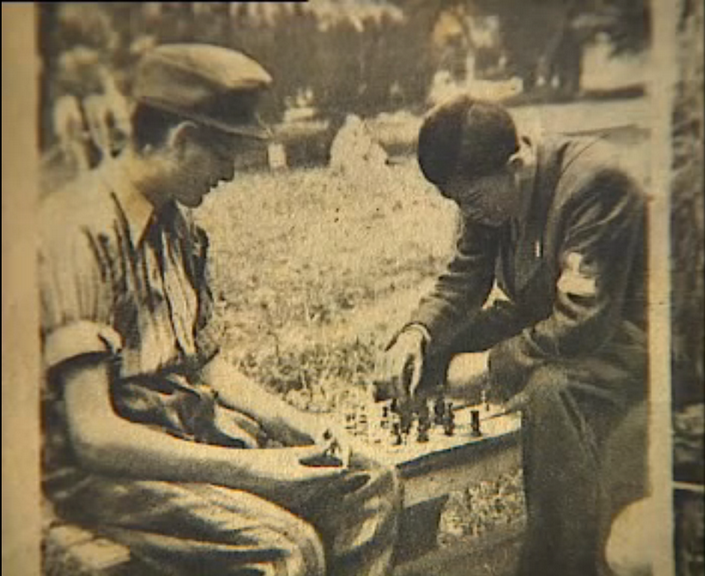
At the end of her video-taped Shoah Foundation testimony in 1995 (the same year Wiesel’s memoir All Rivers Run to the Sea came out), Hilda Wiesel Kudler shows some family pictures: her mother, her father, her sister and brother, and lastly the one above.
Hilda says (translated from French): With the cap, that’s him. My brother with the cap. That is this picture that I saw in Paris and thanks to this picture we met. I was for several months in Paris, as he was too; and we didn’t know we were both alive—and thanks to this picture we met.
Hilda may have been on the look-out for her brother when she saw this photo and thought or hoped it might be him. By contacting that OSE home that was mentioned in the story, and asking about Eliezer Wiesel, they located him there and the brother and sister were reunited. A heartwarming story, but it’s clear to me that the boy in this picture is not Elie Wiesel. Compare the known Elie in the picture below taken at the same time.
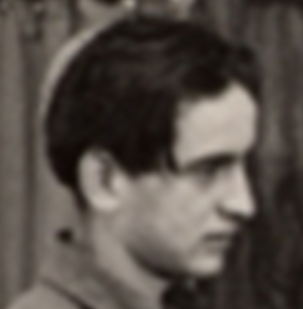
Below is an enlargement of the chess-playing boy. (click twice)
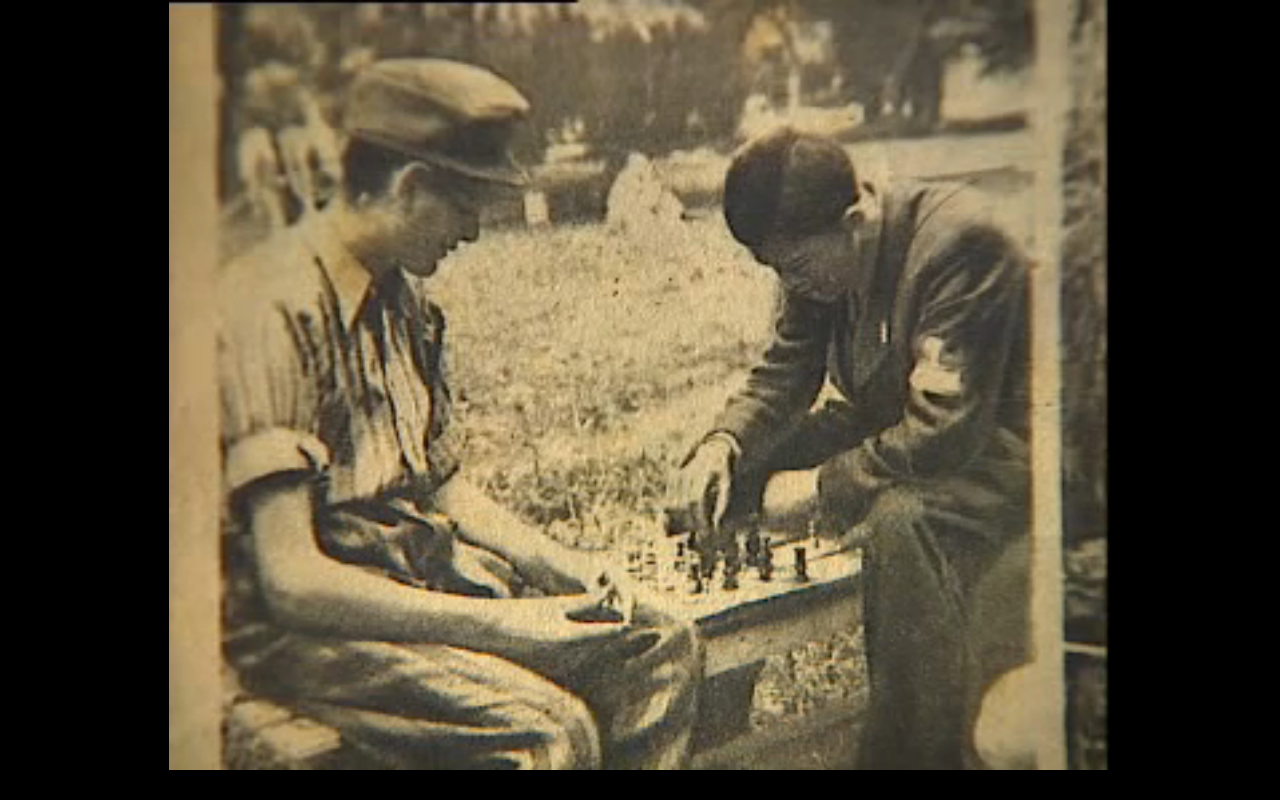
This boy is what you’d call gawky, which young Elie was not as we know from other pictures of him at Ambloy during this same few months of the second half of 1945. This boy’s chin is too long and his ear appears to curve outward away from his head. The nose is short. Both boys faces seem to me to have been retouched in a crude fashion to define the features, especially the eyes. The chess player’s arms and legs are unusually long—compare them to the other boy—which is not true of Wiesel in all the pictures of him we have seen. This suggests he is going to be a tall person, while Elie Wiesel has never been more than 5’9” tall. Clearly this lad is a young adolescent, still growing at an uneven rate. If you, dear reader, can believe this is Wiesel, let me hear from you and give me your reasons.
Another point is that Wiesel always wore a beret, and I don’t think he would be caught dead in a cap like that. Nor in those striped pants. He took himself too seriously to be going about in such garb.
Yet, Elie writes in All Rivers that he remembers the day when two journalists took a picture of him when he was playing chess with another boy If that is indeed the truth, the picture taken of Wiesel was not the picture published in the newspaper that Hilda Wiesel saw. As I wrote in Elie Wiesel and the Mossad:
Wiesel says he “rededicated” himself to his sacred studies, and in between played chess. One day:
…a couple of strangers wanted to take pictures as we played. One of them asked some questions in bad German; I answered in good Yiddish. Someone said they were journalists, but I had never met a journalist before; they were of no interest to me, and I didn’t see why I should interest them. (All Rivers, p 113)
Here Wiesel’s orthodox Jewish “apartness” reveals itself. Those in the non-Jewish world were of no interest, unless and until they were needed for some purpose. But the question at hand is whether Hilda still believes this is a photo of her brother, or whether she is in on the creation of the Wiesel family legend. Elie must know it is not him, but he seems to attempt to affirm it is when he writes in All Rivers that “they were of no interest to me”—aligning with the boy in the photograph who does in fact look disinterested.
If Elie Wiesel were honest, he would declare the picture his sister saw was NOT of him playing chess. Would that take too much away from his sister’s feeling of pride or importance that she happened to recognize him in a newspaper? When feelings are more important than truth, the actual truth can be shape-shifted in any number of ways.
This is the way of Jews—not only about their imagined holocaust but concerning their affairs in general—that the rest of us don’t quite understand and should not be forced to go along with. If they want to lie to themselves, fine, but don’t lie to us. We should call them on it. That’s what I think.
10 Comments
Category Featured | Tags: Tags: chess players, Elie Wiesel, Hilda Wiesel, OSE, Shoah Foundation,
Social Networks: Facebook, Twitter, Google Bookmarks, del.icio.us, StumbleUpon, Digg, Reddit, Posterous.
 Haley’s bed on which she was tied to be burned to death. The same was done to her younger sister.
Haley’s bed on which she was tied to be burned to death. The same was done to her younger sister.












